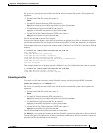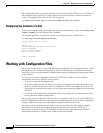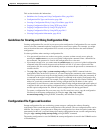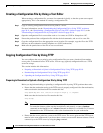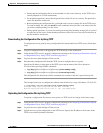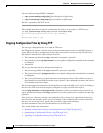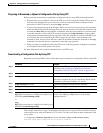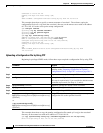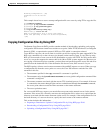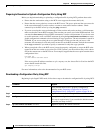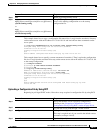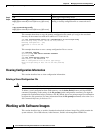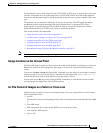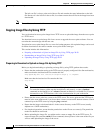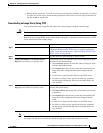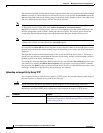
20-15
Cisco IOS Software Configuration Guide for Cisco Aironet Access Points
OL-11350-01
Chapter 20 Managing Firmware and Configurations
Working with Configuration Files
Building configuration...[OK]
Connected to 172.16.101.101
ap#
This example shows how to store a startup configuration file on a server by using FTP to copy the file:
ap# configure terminal
ap(config)# ip ftp username netadmin2
ap(config)# ip ftp password mypass
ap(config)# end
ap# copy nvram:startup-config ftp:
Remote host[]? 172.16.101.101
Name of configuration file to write [ap2-confg]?
Write file ap2-confg on host 172.16.101.101?[confirm]
![OK]
Copying Configuration Files by Using RCP
The Remote Copy Protocol (RCP) provides another method of downloading, uploading, and copying
configuration files between remote hosts and the access point. Unlike TFTP, which uses User Datagram
Protocol (UDP), a connectionless protocol, RCP uses TCP, which is connection-oriented.
To use RCP to copy files, the server from or to which you will be copying files must support RCP. The
RCP copy commands rely on the rsh server (or daemon) on the remote system. To copy files by using
RCP, you do not need to create a server for file distribution as you do with TFTP. You only need to have
access to a server that supports the remote shell (rsh). (Most UNIX systems support rsh.) Because you
are copying a file from one place to another, you must have read permission on the source file and write
permission on the destination file. If the destination file does not exist, RCP creates it for you.
The RCP requires a client to send a remote username with each RCP request to a server. When you copy
a configuration file from the access point to a server, the Cisco IOS software sends the first valid
username in this list:
• The username specified in the copy command if a username is specified.
• The username set by the ip rcmd remote-username username global configuration command if the
command is configured.
• The remote username associated with the current TTY (terminal) process. For example, if the user
is connected to the router through Telnet and was authenticated through the username command,
the access point software sends the Telnet username as the remote username.
• The access point host name.
For a successful RCP copy request, you must define an account on the network server for the remote
username. If the server has a directory structure, the configuration file is written to or copied from the
directory associated with the remote username on the server. For example, if the configuration file is in
the home directory of a user on the server, specify that user's name as the remote username.
This section includes this information:
• Preparing to Download or Upload a Configuration File by Using RCP, page 20-16
• Downloading a Configuration File by Using RCP, page 20-16
• Uploading a Configuration File by Using RCP, page 20-17



